NGR 5700 Moral Distress in Nursing Presentation PPT Example
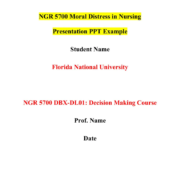 NGR 5700 – Moral Distress in Nursing Presentation PPT Assignment
NGR 5700 – Moral Distress in Nursing Presentation PPT Assignment
NGR 5700 DBX-DL01: Decision Making Course
Florida National University
Course Information
Course Number: NGR 5700
Course Title: Decision Making
Course Credits: 3.0000
NGR 5700 Moral Distress in Nursing Presentation PPT Assignment Brief
Assignment Instructions Overview:
This assignment requires students to design a PowerPoint presentation (10–15 slides) centered around a unique and original nursing situation that reflects the concept of moral distress as experienced by an advanced practice nurse (APN). The scenario should highlight a real-world ethical dilemma encountered in advanced nursing practice, thoroughly demonstrating how it qualifies as moral distress based on definitions from scholarly literature.
For top-quality coursework writing help and assignment writing services, trust Reliable Papers. Our expert team delivers 100% original human-written work tailored to your needs. Contact us via phone, WhatsApp, or live chat for assistance today and get the most reliable research paper help!
Students will explore how personal, professional, and organizational factors contribute to the experience of moral distress and will analyze how this distress differs from other related ethical responses such as moral uncertainty, moral dilemma, moral conflict, and moral residue. Additionally, the presentation must propose and evaluate evidence-based strategies to address moral distress at all three levels—personal, professional, and organizational—while also integrating insights from current research and course readings.
Presentations must be visually engaging, utilize speaker notes to explain content (no large blocks of text on slides), and follow APA 7th edition formatting for all references.
Understanding Assignment Objectives:
The purpose of this assignment is to deepen students’ understanding of how moral distress manifests in advanced practice settings and how it can impact clinical decision-making, personal integrity, and patient outcomes. By developing an original case scenario and evaluating it through a research-informed lens, students will learn to:
- Recognize the ethical and emotional dimensions of advanced nursing practice.
- Differentiate types of ethical conflict.
- Critically examine sources of moral distress.
- Develop targeted interventions that align with professional values and institutional structures.
- Communicate complex ethical concepts clearly and concisely using multimedia tools.
The Student’s Role:
As an advanced nursing student, your role is to adopt the perspective of an APN navigating a morally distressing clinical scenario. You will act as a reflective practitioner, ethical analyst, and systems thinker—exploring how internal values and external constraints intersect to produce moral distress.
You will also assume responsibility for identifying realistic, evidence-based solutions that support the well-being of both the provider and the patient while aligning with legal, institutional, and ethical standards of care. This includes evaluating current best practices, identifying systemic barriers, and recommending interventions tailored to your scenario.
Competencies Measured:
This assignment is designed to assess and strengthen the following graduate-level nursing competencies:
- Ethical Reasoning and Clinical Judgment: Analyze ethical challenges and apply moral reasoning to resolve practice-based dilemmas.
- Leadership and Advocacy: Demonstrate leadership in addressing complex moral issues at the bedside, team, and system levels.
- Scholarly Communication: Use clear, structured, and scholarly communication to convey ethical concepts and support arguments with academic evidence.
- Reflective Practice: Identify personal and professional values, experiences, and biases influencing moral decisions and responses.
- Systems-Based Practice: Evaluate how institutional policies, interdisciplinary dynamics, and workplace culture contribute to or alleviate moral distress.
- Application of Evidence-Based Practice: Integrate scholarly research to frame the issue, support analysis, and inform practical recommendations.
Check out another task that our nursing essay writing services have assisted another student on NGR 5700 Decision Making Process Paper Example.
NGR 5700 Moral Distress in Nursing Presentation PPT Example
Slide 1: Title Slide
Title: Moral Distress in Nursing: An Advanced Practice Nurse’s Perspective
Subtitle: Exploring Ethical Challenges and Solutions in Clinical Practice
Presented by: [Your Name]
Course: NGR 5700 – Ethical Decision-Making in Nursing Practice
Date: [Insert Date]
Slide 2: Introduction to Moral Distress
- Moral distress occurs when one knows the right action but is constrained from acting on it.
- Common in nursing when external barriers impede ethical actions.
- Particularly relevant to the role of the Advanced Practice Nurse (APN).
Speaker Notes:
Moral distress is not just frustration; it’s a deep psychological and emotional response to being unable to take ethically appropriate action. As advanced practice nurses, we often face systemic, hierarchical, or organizational obstacles that prevent us from acting on our ethical knowledge. According to Jameton (1984), moral distress arises in situations where the nurse knows the ethically appropriate action to take but feels powerless to act due to institutional constraints.
*Citation: Jameton, A. (1984). Nursing Practice: The Ethical Issues. Prentice-Hall.
Slide 3: Case Scenario – APN and Palliative Sedation Refusal
- Patient: Mr. L, 74, terminal pancreatic cancer, high suffering.
- Family refuses palliative sedation due to religious beliefs.
- APN believes it’s ethically necessary to relieve intractable suffering.
Speaker Notes:
Mr. L is suffering significantly from terminal cancer-related pain and anxiety. As the APN managing his palliative care, I recommended continuous palliative sedation, which is medically and ethically justified under the principle of double effect. However, the patient’s family refuses sedation, insisting that suffering is part of their religious values. The APN experiences moral distress from knowing what should be done, but being unable to proceed due to external constraints.
*Citation: McCarthy, J., & Gastmans, C. (2015). Moral distress: A review of the argument-based nursing ethics literature. Nursing Ethics, 22(1), 131-152.
Slide 4: How the Scenario Illustrates Moral Distress
- APN knows the ethically appropriate course (palliative sedation).
- Institutional policy and family beliefs restrict action.
- Meets core definition: constraint + ethical knowledge.
Speaker Notes:
This case fits the definition of moral distress as it involves ethical clarity coupled with action constraints. Despite clinical guidelines supporting palliative sedation for intractable suffering (Cherny & Radbruch, 2009), the APN cannot implement it due to family objection and legal hesitancy by the institution, causing emotional and ethical distress.
*Citation: Cherny, N., & Radbruch, L. (2009). European Association for Palliative Care (EAPC) framework for palliative sedation. Palliative Medicine, 23(7), 581–593.
Slide 5: Personal Factors Contributing to Moral Distress
- Empathy for patient’s pain.
- Fear of legal consequences.
- Conflict between personal ethics and professional limitations.
Speaker Notes:
On a personal level, the APN is deeply troubled by the patient’s suffering. They feel a moral obligation to reduce harm. However, fear of institutional reprisal or legal action restrains them. The emotional burden increases with each shift, leading to emotional exhaustion and a feeling of betrayal of professional values (Rushton, 2018).
*Citation: Rushton, C. H. (2018). Moral Resilience: Transforming Moral Suffering in Healthcare. Oxford University Press.
Slide 6: Professional Factors Contributing to Moral Distress
- Role conflict: advocate vs. policy follower.
- Ethical obligation vs. hierarchical limitations.
- Fear of professional isolation.
Speaker Notes:
As an APN, there is an ethical expectation to advocate for optimal patient care. However, the hierarchical structure in the hospital limits autonomy. Physicians and legal advisors influence final decisions. This tension can diminish the APN’s sense of professional agency, reinforcing moral distress (Epstein & Delgado, 2010).
*Citation: Epstein, E. G., & Delgado, S. (2010). Understanding and addressing moral distress. Online Journal of Issues in Nursing, 15(3), Manuscript 1.
Slide 7: Organizational Factors Contributing to Moral Distress
- Risk-averse policies.
- Lack of ethics consultation services.
- Inadequate support systems.
Speaker Notes:
Institutional policies often prioritize legal protection over patient-centered care. In this case, the hospital’s risk management team advised against sedation without explicit consent. Furthermore, the absence of a rapid-response ethics consultation service compounded the issue. These systemic barriers heighten APNs’ moral distress (Hamric et al., 2012).
*Citation: Hamric, A. B., et al. (2012). Moral distress in health care professionals. Pharos Alpha Omega Alpha Honor Med Soc, 75(1), 20-26.
Slide 8: Personal-Level Strategies for Resolution
- Reflective practice.
- Moral resilience training.
- Peer debriefing.
Speaker Notes:
Developing moral resilience helps APNs navigate these ethical challenges. Techniques like journaling, mindfulness, and regular ethical reflection can help prevent burnout and preserve integrity. Peer support groups allow for shared experiences and validation (Rushton, 2016).
*Citation: Rushton, C. H. (2016). Moral resilience: A capacity for navigating moral distress in critical care. AACN Advanced Critical Care, 27(1), 111–119.
Slide 9: Professional-Level Strategies for Resolution
- Ethical education and simulation.
- Professional advocacy.
- Interdisciplinary ethics rounds.
Speaker Notes:
Advanced practice nurses benefit from continuous ethics education. Case-based simulations enhance ethical decision-making skills. Furthermore, engaging in interdisciplinary ethics rounds ensures that APNs can voice concerns and propose alternatives within their professional role (Dodek et al., 2016).
*Citation: Dodek, P. M., et al. (2016). Moral distress in intensive care unit professionals is associated with profession, age, and years of experience. Journal of Critical Care, 31(1), 178-183.
Slide 10: Organizational-Level Strategies for Resolution
- Institutional ethics committees.
- Anonymous reporting systems.
- Policies supporting APN autonomy.
Speaker Notes:
Hospitals must implement structures that support ethical practice. This includes robust ethics committees accessible in urgent cases, safe whistleblowing channels, and policies that recognize and protect APN decision-making authority (Morley et al., 2019).
*Citation: Morley, G., et al. (2019). Addressing moral distress in clinical practice: Ethics consultation and support. Nursing Ethics, 26(8), 1177–1186.
Slide 11: Distinguishing Moral Distress from Other Ethical Responses
| Term | Definition |
| Moral Distress | Knowing the right thing but unable to act |
| Moral Uncertainty | Unsure what the right thing is |
| Moral Dilemma | Two or more conflicting ethical principles apply |
| Moral Conflict | Disagreement between stakeholders over what is ethical |
| Moral Residue | Lingering feelings after moral distress or compromise |
Speaker Notes:
It’s important to differentiate moral distress from other responses. In our case, the APN experiences moral distress—not uncertainty or dilemma—because the ethically correct action is clear. Over time, unresolved distress may lead to moral residue, resulting in burnout or disengagement.
*Citation: Fourie, C. (2015). Moral distress and moral conflict in clinical ethics. Bioethics, 29(2), 91–97.
Slide 12: Ethical Frameworks Supporting APN Action
- Principle of Beneficence.
- Principle of Autonomy.
- Principle of Nonmaleficence.
Speaker Notes:
Ethical principles support the APN’s intentions. Beneficence drives the desire to relieve suffering. Autonomy applies to the patient’s right to receive comfort measures. Nonmaleficence warns against prolonging unnecessary pain. These principles validate the APN’s moral reasoning.
*Citation: Beauchamp, T. L., & Childress, J. F. (2013). Principles of Biomedical Ethics (7th ed.). Oxford University Press.
Slide 13: Summary
- Moral distress is a serious ethical concern in APN practice.
- Rooted in personal, professional, and institutional barriers.
- Addressed through resilience, education, and system change.
- Clear distinction from other ethical responses.
Speaker Notes:
In conclusion, moral distress in APN roles requires layered understanding and response. Through ethical advocacy, education, and resilience, nurses can navigate these challenges while protecting their professional integrity and patient welfare.
Slide 14: References
- Beauchamp, T. L., & Childress, J. F. (2013). Principles of Biomedical Ethics.
- Cherny, N., & Radbruch, L. (2009). Palliative Medicine.
- Dodek, P. M., et al. (2016). Journal of Critical Care.
- Epstein, E. G., & Delgado, S. (2010). OJIN.
- Fourie, C. (2015). Bioethics.
- Hamric, A. B., et al. (2012). Pharos.
- Jameton, A. (1984). Nursing Practice.
- McCarthy, J., & Gastmans, C. (2015). Nursing Ethics.
- Morley, G., et al. (2019). Nursing Ethics.
- Rushton, C. H. (2016; 2018). AACN Advanced Critical Care; Oxford University Press.
Detailed Assessment Instructions for the NGR 5700 Moral Distress in Nursing Presentation PPT Assignment
Moral Distress in Nursing Presentation PPT
General Guidelines:
Create a nursing situation (must be original; meaning there should not be any two presented in class that are the same as any other student) which illustrates moral distress related to a clinical problem that an advanced practice nurse is likely to encounter in practice. Ensure to define and explain how the scenario meets the definition of moral distress and that the problem as identified in the nursing situation is supported by evidence-based literature. Describe the personal, professional and organizational factors that are the causes of moral distress within the case scenario from the perspective of the APN. Analyze current interventions and strategies to address the identified issue of moral distress in the created nursing situation at the personal, professional and organizational level. Differentiate moral distress from other common responses to ethical situations encountered in practice (moral uncertainty, dilemma, conflict and residue).
- Presentation should be between 10-15 slides.
- Each content slide should be succinct and have no long paragraphs to read.
- Utilize notes pages may be utilized for explanation if needed and to expand on subject area to cover all criteria on rubric.
- Use pictures to enhance presentation.
Content Criteria: (see below)
- Nursing situation clearly describes and explores moral distress related to an ethical practice issue from the perspective of an advanced practice nurse which is linked to current best practice, research and literature.
- Analysis & Evaluation of Moral Distress is clearly demonstrated as an ethical issue from the perspective of the advanced practice nurse within the nursing situation
- Personal, professional, and organizational causes of moral distress are explained and clearly illustrated using the nursing situation.
- Recommendations on Effective Interventions and Strategies from a personal, professional and organizational perspective are demonstrated and explained using the nursing situation.:
- Explores the differences between moral distress and moral uncertainty, dilemma, conflict and residue from the perspective of the advanced practice nurse.
- Writing Mechanics and Formatting Guidelines are clear and the concept of moral distress from the perspective of an advanced practice nurse is well supported using evidence-based research and literature throughout the presentation.
PowerPoint Presentation Rubric
| CRITERION | STRONG | AVERAGE | WEAK |
| Nursing situation clearly describes and explores moral distress related to an ethical practice issue from the perspective of an advanced practice nurse (15%) | 10-15 pts
Nursing situation identifies, describes and demonstrates a sophisticated understanding of moral distress as an ethical practice issue and dilemma from the perspective of an advanced practice nurse (APN). |
5-9 pts
Nursing situation identifies, describes, and demonstrates a somewhat accomplished understanding of moral distress as an ethical practice issue and dilemma from the perspective of an advanced practice nurse (APN). |
0-4 pts
Nursing situation identifies, describes, and demonstrates an unclear understanding of moral distress as an ethical practice issue and dilemma from the perspective of an advanced practice nurse (APN). |
| Analysis and Evaluation of Ethical Dilemma
15% |
10-15 pts
Presents an insightful and thorough analysis of moral distress using a clinical practice issue that is well supported with best practice and current research which relates specifically to |
5-9 pts
Presents a somewhat thorough analysis of moral distress using a clinical practice issue that is somewhat but not clearly supported with best practice and current research and |
0-4 pts
Little to no analysis of moral distress using a clinical practice issue that is not well supported with best practice and current research and fails to show a specific link to |
| the role of APN versus a bedside nurse is illustrated using the
nursing situation. |
somewhat relates to the role of APN versus a bedside nurse. | the role of APN versus a bedside nurse. | |
| Personal, professional, and organizational causes of moral distress are explained and clearly illustrated using the nursing situation (15%) | 10-15 pts
Exceptional exploration of personal, professional and organizational causes of moral distress is presented and illustrated using the identified nursing situation. |
5-9 pts
Appropriate but somewhat vague exploration of personal, professional and organizational causes of moral distress is presented and illustrated using the identified nursing situation. |
0-4 pts
Little to no exploration of personal, professional and organizational causes of moral distress is presented and illustrated using the identified nursing situation. |
| Recommendations on effective interventions
Solutions/Strategies from a personal, professional and organizational perspective are demonstrated and explained using the nursing situation
(15%) |
10-15 pts
Sophisticated explanation of effective interventions and strategies from a personal, professional and organizational perspective are provided to address moral distress as illustrated in the nursing situation which are clearly linked and supported by evidence based best practice and literature. |
5-9 pts
Appropriate explanation of effective interventions and strategies from a personal, professional and organizational perspective are provided to address moral distress as illustrated in the nursing situation which are somewhat linked and supported by evidence based best practice and literature. |
0-4 pts
Limited explanation of effective interventions and strategies from a personal, professional and organizational perspective are provided to address moral distress as illustrated in the nursing situation which are not clearly linked and/or supported by evidence based best practice and literature |
| Explores the differences between moral distress and moral uncertainty, dilemma, conflict and residue from the perspective of the | 10-15 pts
Integrated and full descriptions of how moral distress differs from the other ethical responses of moral uncertainty, moral |
5-9 pts
Somewhat integrated but not full description of how moral distress differs from the other ethical responses of moral uncertainty, moral |
0-4 pts
Limited to no description of how moral distress differs from the other ethical responses of moral uncertainty, moral |
| advanced practice nurse.
(15%) |
dilemma, moral conflict and moral residue from the perspective of the advanced practice
nurse. |
dilemma, moral conflict and moral residue from the perspective of the advanced practice nurse | dilemma, moral conflict and moral residue from the perspective of the advanced practice
nurse |
| Links ethical dilemma of moral distress to Course Readings and Additional Literature &
Research (15%) |
10-15 pts
Makes appropriate connections between |
5-9 pts
Makes appropriate but somewhat vague connections between identified ethical and moral issues from both sides; supplements presentation with some relevant and thoughtful research and documents all sources of information. |
0-4 pts
Makes inappropriate or little connections between identified ethical and moral issues from both sides; supplements presentation with some relevant and thoughtful research and documents all sources of information. |
| identified ethical and moral issues from both | |||
| sides; supplements | |||
| presentation with | |||
| relevant and | |||
| thoughtful research | |||
| and documents all | |||
| sources of information. | |||
| Writing Mechanics and Formatting Guidelines including correct references and APA
formatting |
8-10 pts Demonstrates clarity,
conciseness and |
4-7 pts
Occasional grammar or spelling errors, but still |
0-3 pts
Many deficiencies on grammar, spelling, or |
|
(10%) |
correctness; no | a clear presentation of | APA formatting. Slides |
| paragraphs to read on | ideas; lacks | have paragraphs to | |
| slides; utilizes notes on | organization. Slides | read and are not | |
| each slide to expand; | contain too much text | concise or notes on | |
| APA formatting is | to read | each slide are not | |
| appropriate and | utilized. | ||
| writing is free of | |||
| grammar and spelling |
| errors | |||
| Total 100 pts |
Boost Your Grades with Our Expert Nursing Paper Writing Services!
Are you grappling with challenging nursing topics? Look no further! ReliablePapers.com is your trusted partner for top-notch nursing writing services. Our dedicated team of skilled nursing essay writers is committed to crafting customized and original human-written nursing papers, ensuring academic success.
Making Nursing Assignments a Breeze
Whether you’re tackling complex topics, facing tight deadlines, or dealing with specific instructions, we’ve got you covered. From creating custom nursing research papers to assisting with nursing assignments, our professionals are here to support you.
How We Can Help
Our pro nursing writers excel at crafting outstanding human-written nursing essay papers from scratch, addressing any topic, meeting any deadline, and following your specific instructions. At ReliablePapers.com, we recognize the significance of your academic success.
Why Choose Us?
- Affordable Prices: Our online nursing papers are affordably priced, making them accessible to all college students.
- Expert Writers: Let our skilled writers perfect your paper, providing the expertise needed for exceptional results.
- Originality Guaranteed: Bid farewell to plagiarized papers. Our nursing experts create original and customized human-written nursing essays for your academic success.
- Easy Ordering Process: Ready to place your order? It’s hassle-free! Visit our “Place Order” page, provide paper details, proceed to checkout, and your order will be assigned to a suitable expert.
Why Trust Our Professionals?
Our experts at ReliablePapers.com stay updated with the latest nursing trends, ensuring your nursing research paper stands out. Trust us for the best nursing writing services that meet your desires and ensure timely submissions.
Save Time and Secure Top Grades
Ready to save time and secure the grades you deserve? Visit our “Place Order” page, fill in your paper details, proceed to checkout, and trust us to make your nursing papers perfect. Don’t wait until the last minute; fill in your requirements and let our experts deliver your work ASAP.
Hire an Expert Paper Writer on Any Subject, Any Topic, Any Deadline! Submit your paper instructions by placing your order here to get started!


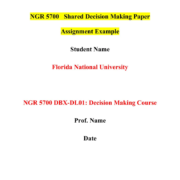 NGR 5700 – Shared Decision-Making Paper Assignment
NGR 5700 – Shared Decision-Making Paper Assignment


 NRSG266 Principles of Nursing Contexts of Ageing Assessments Assignments
NRSG266 Principles of Nursing Contexts of Ageing Assessments Assignments Assignment Brief: NURS4221 FADE Performance Improvement Model Example
Assignment Brief: NURS4221 FADE Performance Improvement Model Example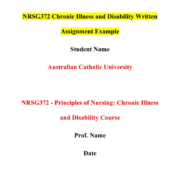 NRSG372 Chronic Illness and Disability Written Assignment
NRSG372 Chronic Illness and Disability Written Assignment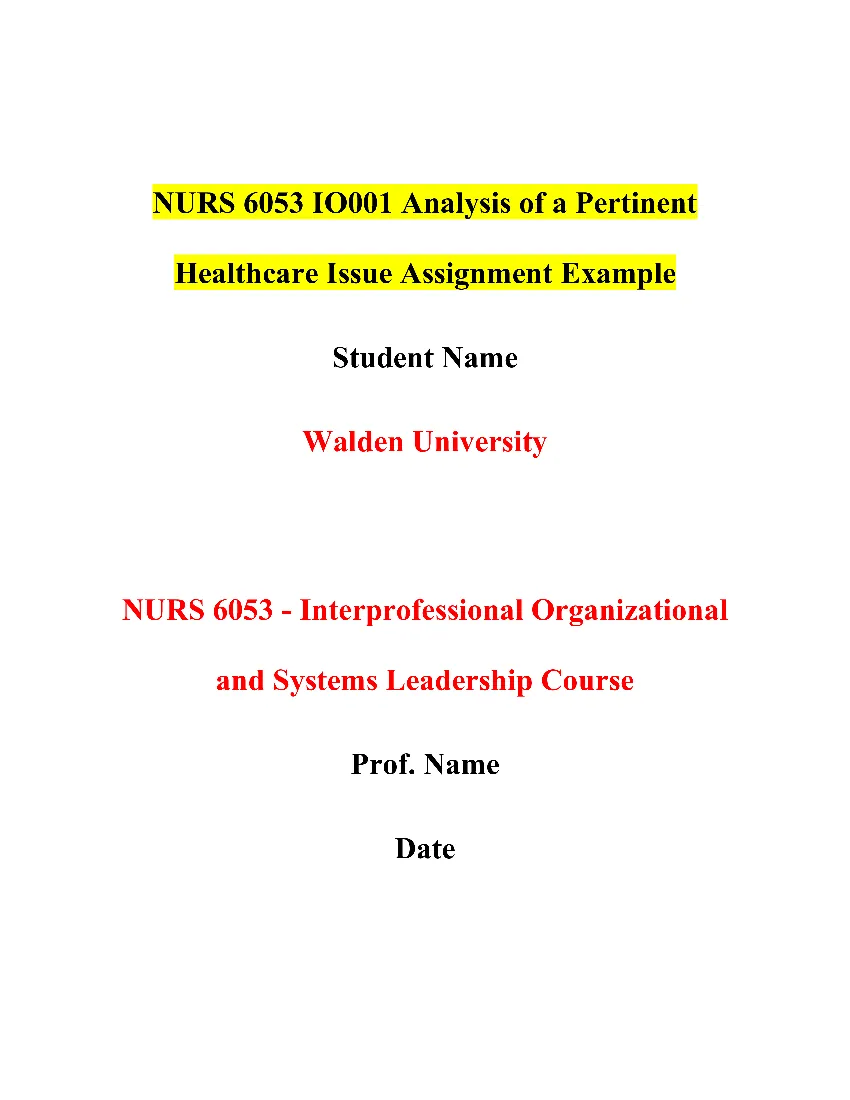 NURS 6053 IO001 Analysis of a Pertinent Healthcare Issue Assignment
NURS 6053 IO001 Analysis of a Pertinent Healthcare Issue Assignment
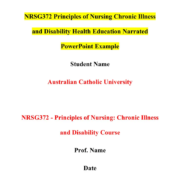 NRSG372 Principles of Nursing Chronic Illness and Disability Health Education Narrated PowerPoint Assignment Example
NRSG372 Principles of Nursing Chronic Illness and Disability Health Education Narrated PowerPoint Assignment Example